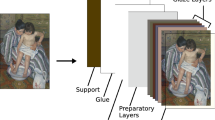Summary
Dynamic mechanical thermal analysis (DMTA), differential scanning calorimetry (DSC) and thermogravimetry (TG) have been used to characterise model tapestries, especially woven for the EC-funded project (MODHT) and to historic tapestries in royal palaces and museums. Modulus values of woollen threads from model tapestries are reported and the effects of traditional dyeing and mordanting processes quantified. TG, particularly of black woollen threads showed alterations in thermal stability. Tests of creep on immersion in water and subsequent heating to 90°C and on exposure to a controlled relative humidity programme were also used to rank these effects. Modulus values of historic woollen samples were also obtained and DSC studies of model and historic silk samples are reported together with preliminary atomic force microscopy (AFM) images of silk fibres.
Similar content being viewed by others
Explore related subjects
Discover the latest articles, news and stories from top researchers in related subjects.Author information
Authors and Affiliations
Rights and permissions
About this article
Cite this article
Odlyha, M., Wang, Q., Foster, G. et al. Thermal analysis of model and historic tapestries. J Therm Anal Calorim 82, 627–636 (2005). https://doi.org/10.1007/s10973-005-0943-8
Issue Date:
DOI: https://doi.org/10.1007/s10973-005-0943-8




